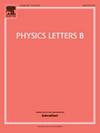通过飞镜研究探索φ -α相互作用
IF 4.3
2区 物理与天体物理
Q1 ASTRONOMY & ASTROPHYSICS
引用次数: 0
摘要
最近,在单折叠电位(SFP)方法中构建了Wood-Saxon (WS)型相互作用来模拟φ -α电位。其中一组的ϕ-α势是基于S3/24通道中第一原理HAL QCD的ϕ-α相互作用,另一组的ϕ-α势是采用夸克-介子耦合(QMC)模型计算的。利用这两组φ -α势,探讨了高能重离子碰撞中φ -α的两粒子动量相关性。数值结果表明,小源尺寸(高密度核介质)下的相关函数依赖于所采用的势模型。并在Lednicky-Lyuboshits (LL)形式体系内得到相关函数。对于较小的源尺寸,我们发现,由于φ -α势的大相互作用范围,LL公式返回显著不同的值。本文章由计算机程序翻译,如有差异,请以英文原文为准。
Exploring the ϕ-α interaction via femtoscopic study
Very recently the Wood-Saxon (WS) type interaction in the single-folding potential (SFP) approach are constructed to simulate the potentials. One set of the potentials are based on the first principle HAL QCD interactions in channel, and in another set, the ϕ-meson nucleus potentials were calculated by employing the quark-meson coupling (QMC) model. By utilizing these two sets of potentials, the two-particle momentum correlation of in high-energy heavy ion collisions is explored. The numerical results show that the correlation functions at small source size (high density nuclear medium) depend on the employed potential model. Also, the correlation functions are obtained within the Lednicky-Lyuboshits (LL) formalism. For small source size, it is found that, the LL formula returns significantly different values due to the large interaction range of the potential.
求助全文
通过发布文献求助,成功后即可免费获取论文全文。
去求助
来源期刊

Physics Letters B
物理-物理:综合
CiteScore
9.10
自引率
6.80%
发文量
647
审稿时长
3 months
期刊介绍:
Physics Letters B ensures the rapid publication of important new results in particle physics, nuclear physics and cosmology. Specialized editors are responsible for contributions in experimental nuclear physics, theoretical nuclear physics, experimental high-energy physics, theoretical high-energy physics, and astrophysics.
 求助内容:
求助内容: 应助结果提醒方式:
应助结果提醒方式:


